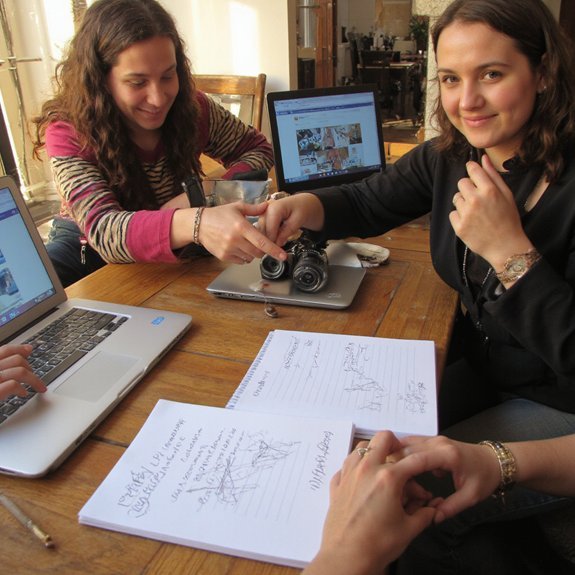When you collaborate with other bloggers, you’ll expand reach, share resources, and boost authority in your niche. Start by finding partners whose audience and values align, then pitch a clear, benefit-driven idea and agree on roles, deadlines, and promotion. Keep the process measurable—and in the next section you’ll get a step-by-step outreach script that actually gets responses.
Key Takeaways
- Define shared goals and target audience before outreach so collaboration aligns with measurable outcomes (traffic, backlinks, leads, or subscriptions).
- Find compatible bloggers via niche keywords, hashtags, communities, and analytics to ensure audience overlap and values alignment.
- Send a personalized, one-line hook pitch that shows audience benefit and includes brief metrics or a relevant case study.
- Agree on format, keyword strategy, clear roles, deadlines, and a coordinated promotion schedule using shared documents.
- Set joint KPIs, track performance, and run a post-launch retrospective to optimize future collaborations.
Benefits of Partnering With Fellow Bloggers

When you partner with fellow bloggers, you multiply your reach and accelerate growth: collaborations drive referral traffic, create quality backlinks that boost search rankings, and expose your content to new, engaged audiences. You’ll tap creative synergy that sparks fresh formats, co-authored posts, and cross-promotions that keep readers coming back. Collaborations give you testbeds for ideas, letting you validate content angles and headlines faster while sharing analytics to refine targeting. Expect increased reach through combined audiences, boosted social proof, and higher engagement metrics that search engines notice. You’ll also stretch resources—shared research, split production time, and pooled promotion budgets—so you can scale experiments without extra overhead. Be intentional: set measurable goals, agree on KPIs, and sequence content to feed each partner’s funnel. That strategic approach turns one-off swaps into growth engines, improves discoverability, and drives repeat traffic, positioning your blog as a forward-thinking resource in a crowded landscape today.
Finding Bloggers Who Match Your Niche and Values

Where do you find bloggers who genuinely fit your niche and values? Start by mapping your ideal readership and search platforms they use: Twitter, LinkedIn, Instagram, niche forums, and specialized directories. Use targeted keywords and hashtags to surface creators, then evaluate blog niche alignment by examining content topics, tone, and audience engagement. Scan archives and guest posts to confirm consistency. Prioritize values compatibility—read about pages, social causes, monetization choices, and comment interactions to see if ethics and goals match. Leverage analytics tools (similarweb, ahrefs, social listening) to check traffic sources and audience overlap. Join niche Slack groups, Facebook communities, and industry events to observe reputations and collaborative history. Curate a short list of candidates, noting content formats and platform strengths so collaborations scale efficiently. Keep innovation in mind: look for creators experimenting with formats, emerging platforms, or interdisciplinary angles that complement your strategy. Then prioritize quality over quantity.
Approaching Potential Collaborators With a Clear Pitch

Although you’ve already identified suitable partners, you’ll only win them over with a clear, concise pitch that shows immediate value to their audience and respects their time. Lead with a one-line hook, state the mutual benefit, and offer a simple next step. Use data or a past result to boost credibility and keep the ask specific: short, measurable, and deadline-bound. Respect collaboration etiquette by acknowledging their priorities and preferred contact method. Tailor subject lines and opening sentences for SEO relevance and reader intent.
- One-line hook highlighting audience gain
- Quick evidence (metrics or case study)
- Clear, low-friction next step
Apply proven pitch strategies: personalize each outreach, mirror tone, and link to a brief portfolio or relevant post. Close by thanking them and offering flexibility; that respect increases replies. You want to be memorable, efficient, and clearly useful to their readers. Measure results, iterate, and improve outreach.
Choosing Collaboration Formats That Work for Both Parties
Start by defining shared goals so you both target the same audience and can measure success. Then choose a collaboration format—co-written posts, guest posts, webinars, or social promotions—that aligns with those goals. Finally, agree on clear deliverables, timelines, and promotion responsibilities to avoid confusion and guarantee results.
Define Shared Goals
When you define shared goals, pick collaboration formats that match both blogs’ audiences, content strengths, and measurable KPIs. You should build a shared vision that highlights mutual benefits, audience lift, and SEO gains. Agree on outcomes like reach, conversion, and content depth before choosing format so you focus on impact, not process. Use data to pick formats — guest posts, co-created pillars, or cross-promoted series — that leverage each blog’s strengths and amplify authority. Keep conversations strategic, short, and metric-driven to iterate quickly. Prioritize measurable timelines, scalable experiments, and rapid learning loops to refine what drives growth.
- Guest posts to transfer authority and backlinks
- Co-created pillar content for topical depth and SEO dominance
- Cross-promoted series to test audience overlap and engagement
Agree on Deliverables
For a collaboration to succeed, agree on clear, measurable deliverables tied to formats that suit both audiences and content strengths. You’ll map deliverable expectations—post length, deadlines, promotion windows—and choose collaboration tools that streamline handoffs and approvals. Pick formats that play to each blog’s voice: guest posts, co-authored guides, podcasts, or social snippets. Define KPIs up front (traffic, shares, leads) and who owns each metric. Use a shared calendar and a lightweight brief so you don’t reinvent scope. The table below helps you compare formats fast.
| Format | Strength | Key Deliverable |
|---|---|---|
| Guest post | SEO depth | 1,200–1,800 words |
| Podcast | Engagement | 30–45 minute episode |
| Social series | Reach | 5 posts + CTAs |
Review deliverable expectations monthly and iterate using collaboration tools to optimize outcomes for measurable scalable impact now.
Setting Roles, Deadlines, and Promotion Plans
Before you start, define clear roles so you’re not guessing who’s writing, editing, and publishing. Make sure you agree on firm deadlines to keep the project on track and optimize timing for search and seasonal relevance. Then coordinate a promotion schedule—dates, channels, and messaging—so you boost reach and avoid overlap.
Define Clear Roles
Although collaboration sparks creativity, it flops without clearly assigned roles, deadlines, and promotion plans—so you should map who owns each deliverable, set firm due dates, and outline promotion responsibilities up front. Define clear roles to sharpen role clarity and streamline collaboration dynamics: name lead editor, content owner, and distribution manager so everyone knows decision authority and handoffs. Use shared docs, templates, and a brief RACI to prevent overlap and speed iteration. Focus on outcomes, not tasks, and document expectations for tone, SEO targets, and promotional assets.
- Lead editor: final approval and quality
- Content owner: drafts and research
- Distribution manager: syndication and outreach
When roles are explicit, you’ll accelerate innovation and make collaborations repeatable and measurable. Track responsibilities in one place for ongoing performance improvements.
Agree on Deadlines
When everyone signs off on realistic deadlines up front, you’ll cut review cycles and keep promotional windows intact; assign milestone dates for drafts, edits, asset handoffs, and outreach so timelines align with launch goals. Establish clear owner for each milestone and document deliverables in a shared brief so everyone knows expectations. Build flexible timelines with buffer days for feedback rounds and tech issues, and set escalation steps for missed dates. Use simple tracking—shared spreadsheet or project board—and update status daily to maintain momentum. Reinforce mutual accountability by agreeing on consequences for persistent delays and celebrating timely completions. Regular check-ins and a single source of truth keep collaborators focused, reduce friction, and speed execution without sacrificing quality. Iterate timelines post-launch retrospectives to improve future collaborations.
Coordinate Promotion Schedule
Now that you’ve locked down milestone dates, map out who will promote what, when, and where so each channel hits peak visibility around launch.
- Roles: creators, posters, amplifiers.
- Channels: blog, social, email.
- Deadlines: drafts, approvals, go-live.
Build a shared promotion calendar tied to your content timeline so search signals align with audience peaks. Use concise copy, tailored visuals, and staggered CTAs to avoid overlap and boost reach. Coordinate cross-posts, email blasts, and influencer mentions, and set measurable KPIs. Keep a single source of truth—shared doc or dashboard—that lists deadlines, post copy, links, and tags. Review progress in weekly syncs and adjust timing based on early metrics. That way you’ll optimize visibility and sustain momentum without duplicating effort. Celebrate wins and iterate on promotion tactics.
Creating High-Quality Co-Created Content
How will you produce co-created content that ranks, converts, and reflects both brands? Start by defining a unified keyword strategy and buyer persona so every co authored articles and joint podcasts target the same intent. Agree on tone, CTAs, and publishing formats up front; use an editorial brief with headlines, keywords, and backlink plans. Divide responsibilities by strength—one handles research, the other storytelling—and set technical standards for SEO: headings, schema, meta descriptions, and fast images. Optimize distribution: craft platform-specific snippets, repurpose long-form into short social clips, and coordinate canonical tags to prevent duplicate content issues. Use collaborative tools for version control and a shared content calendar for deadlines. Prioritize original insights, data, and visuals that neither partner could produce alone to increase authority and links. Finally, document the workflow so future collaborations scale efficiently and preserve brand equity. You’ll iterate quickly, testing formats and refining shared messaging consistently.
Measuring Success and Maintaining Long-Term Relationships
After aligning on SEO, distribution, and editorial responsibilities, set joint KPIs so you can measure ranking, organic traffic, lead quality, backlinks, and engagement against the same goals. You’ll use clear metrics tracking to assess each collaboration phase, compare performance, and iterate fast. Schedule monthly reviews, share dashboards, and agree on optimization experiments that prioritize audience intent and conversion velocity. For maintaining momentum, commit to reciprocal promotion rhythms and transparent crediting.
- Agree on KPI definitions and attribution windows
- Share access to analytics dashboards and project timelines and benchmarks
- Plan quarterly innovation sprints to test formats and channels
You should treat relationship building as strategic infrastructure: nurture trust with consistent communication, celebrate wins publicly, and resolve issues with data-driven decisions. Document processes so handoffs are smooth, and set renewal criteria tied to ROI and audience impact. That way, collaborations scale without friction and keep delivering compounded growth.

Leave a Reply